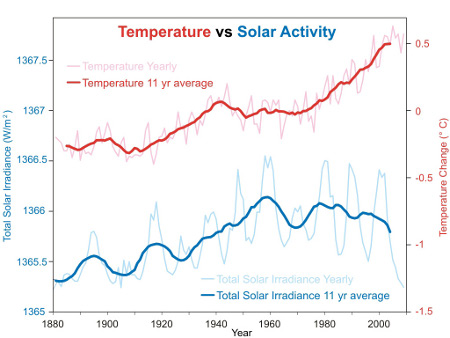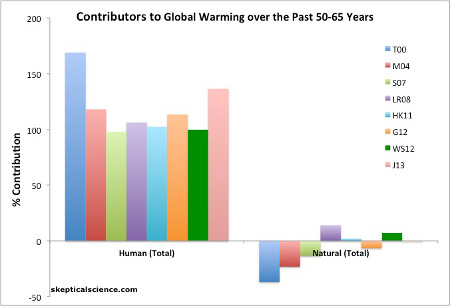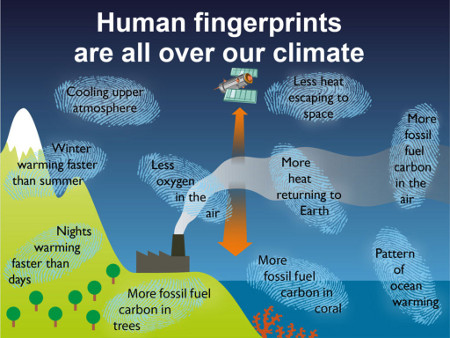Why is the IPCC AR5 so much more confident in human-caused global warming?
Posted on 27 September 2013 by dana1981
![]() Skeptical Science has launched a new feature, a collection of debunkings of the most popular myths about the IPCC. This post has been adapted into a rebuttal of the myth "IPCC human-caused global warming attribution confidence is unfounded". The short URL for this new resource is http://sks.to/ipcc
Skeptical Science has launched a new feature, a collection of debunkings of the most popular myths about the IPCC. This post has been adapted into a rebuttal of the myth "IPCC human-caused global warming attribution confidence is unfounded". The short URL for this new resource is http://sks.to/ipcc
The fifth Intergovernmental Panel on Climate Change (IPCC) report states with 95 percent confidence that humans are the main cause of the current global warming. Many media outlets have reported that this is an increase from the 90 percent certainty in the fourth IPCC report, but actually the change is much more significant than that. In fact, if you look closely, the IPCC says that humans have most likely caused all of the global warming over the past 60 years.
Spot the Differences
Here is the relevant statement from the fourth IPCC report in 2007:
"Most of the observed increase in global average temperatures since the mid-20th century is very likely [90 percent confidence] due to the observed increase in anthropogenic greenhouse gas concentrations
Now here is the statement from the fifth IPCC report:
"It is extremely likely [95 percent confidence] more than half of the observed increase in global average surface temperature from 1951 to 2010 was caused by the anthropogenic increase in greenhouse gas concentrations and other anthropogenic forcings together."
Did you spot the differences? The 2007 IPCC statement focused on human greenhouse gas emissions, while the 2013 statement pertains to all human influences on the climate. This includes the cooling effect from human aerosol emissions (pollutants that scatter sunlight).
Cooling from human aerosol emissions offsets about one-third of the warming from human greenhouse gas emissions. The new IPCC statement says that even taking that aerosol cooling effect into account, humans are still the main cause of the global warming over the past 60 years.
Current Global Warming Caused by Greenhouse Gases, Not Nature
The IPCC elaborates further.
What's causing global warming: human greenhouse gas emissions.
"The best estimate of the human-induced contribution to warming is similar to the observed warming over this period ... The observed warming since 1951 can be attributed to the different natural and anthropogenic drivers and their contributions can now be quantified. Greenhouse gases contributed a global mean surface warming likely to be in the range of 0.5°C to 1.3 °C over the period 1951−2010, with the contributions from other anthropogenic forcings, including the cooling effect of aerosols, likely to be in the range of −0.6°C to 0.1°C."
What's not causing global warming: natural external factors like solar activity, and natural internal factors like ocean cycles.
"The contribution from natural forcings is likely to be in the range of −0.1°C to 0.1°C, and from internal variability is likely to be in the range of −0.1°C to 0.1°C."
We've observed about 0.6°C average global surface warming over the past 60 years. During that time, the IPCC best estimate is that greenhouse gases have caused about 0.9°C warming, which was partially offset by about 0.3°C cooling from human aerosol emissions. During that time, natural external factors had no net influence on global temperatures. For example, solar activity has been flat since 1950.
Annual global temperature change (thin light red) with 11 year moving average of temperature (thick dark red). Temperature from NASA GISS. Annual Total Solar Irradiance (TSI; thin light blue) with 11 year moving average of TSI (thick dark blue). TSI from 1880 to 1978 from Krivova et al (2007). TSI from 1979 to 2009 from PMOD.
As for the natural internal variability of the Earth's climate system, short-term noise averages out to zero over long time frames. Warm and cool ocean cycles cancel each other out, and thus internal variability has no long-term influence on average global temperatures.
Put it all together, and the IPCC is 95 percent confident that humans have caused most of the observed global surface warming over the past 60 years. Their best estimate is that humans have caused 100 percent of that global warming.
IPCC is Summarizing the Scientific Research
The IPCC does not conduct any original research; it's a summary report, and these statements accurately reflect the body of climate science research. For example, last year climate scientists Tom Wigley and Ben Santer published a paper concluding that human climate influences were responsible for 50 to 150 percent of the observed warming from 1950 to 2005.
Like this new IPCC statement, they found that humans have caused at least half the observed warming since 1950, and most likely all of it. It's also possible that humans have caused more warming than has been observed because natural factors may have had a net cooling effect. The Wigley and Santer results are consistent with the body of scientific research on the causes of global warming.
Net human and natural percent contributions to the observed global surface warming over the past 50-65 years according to Tett et al. 2000 (T00, dark blue), Meehl et al. 2004 (M04, red), Stone et al. 2007 (S07, light green), Lean and Rind 2008 (LR08, purple), Huber and Knutti 2011 (HK11, light blue), Gillett et al. 2012 (G12, orange), Wigley and Santer 2012 (WS12, dark green), and Jones et al. 2013 (J12, pink).
The 'fingerprints' of climate change are also all consistent with what we expect to see as a result of human-caused global warming, for example changes in the atmosphere, as another paper by Ben Santer recently concluded.
Summary of observational evidence that human carbon dioxide emissions are causing the climate to warm.
What About the Naysayers?
A few naysayers like Judith Curry from Georgia Tech have disputed the IPCC confidence on this question, for example in an interview with the reliably inaccurate David Rose.
However, while Curry is a climate scientist, she doesn't research the causes of global warming. She also has a history of exaggerating climate uncertainties. Her comments are inconsistent with the body of scientific research on the subject. Put simply, she is speaking outside her area of expertise, like a podiatrist giving advice on open heart surgery.
The 97 Percent Consensus is Evidence-Based
This is why there's a 97 percent consensus amongst climate experts and in the climate science literature that humans are causing global warming. The scientific evidence on this question is overwhelming.
Many commenters have noted that the expert consensus is itself not scientific evidence for human-caused global warming. That's true. The expert consensus is however based on the scientific evidence. The fact that 97 percent of climate experts agree on this subject also demonstrates the strength of the scientific evidence on human-caused global warming. And the strength of the evidence is why the IPCC is able to say with 95 percent confidence that humans are the main cause of the current global warming.
Check out more debunkings of IPCC myths at http://sks.to/ipcc































 Arguments
Arguments


































empirical_bayes - I'm a bit puzzled by your post. If the probability distribution function for data or models is taken from previous information, there are still (although unlikely) high-sigma deviations possible in projections, temperatures outside observed ranges due to observed variances. Standard deviations don't have hard limits.
I'll note that your colored ball/urn example requires that you assign (not estimate, not without additional assumptions) probabilities for the frequency of unobserved categories - and category presence not the same thing as looking at the variance of a single variable.
That said, the Bayesian realm of statistics is not a field I am expert in, and I may well be incorrect...
Can anyone give me a rough idea of how they get a number like, say, 95% as opposed to 90%
dvaytw, those values come from statistical math.
Basically, they are calculating the mathematical likelihood that the observed data could have occured due to random variation as opposed to some underlying trend. The calculations are similar to those used to determine the +/- ranges you see on polls or uncertainty bands on graphs, but in this case they are looking for a 'true/false' likelihood rather than a range.
The posts below discuss issues around interpreting statistical significance in relation to the recent atmospheric warming trend;
Has Global Warming Stopped
On Statistical Significance and Confidence
Temperature Trend Calculator
If you want to look at the actual math, the simplest version of this kind of test would be;
Chi square tutorial
dvaytw @52, the first thing to notice is that if you do a like with like comparison, AR5 only gets a 90% rather than the 95%. Here are the two relevant statements from the two reports:
IPCC AR4 Chapt 9, Executive Summary:
IPCC AR5 Chapt 10, Executive Summary:
So, both reports indicate that it is "very likely" that greenhouse gases have caused more than half of the warming since 1950. AR5 gives a stronger result, but only by extending the duration of the finding forward to 2010 (ie, about 5 years).
The 95% figure is for a different value. AR5 (Chapt 10, Executive Summary) states:
The key difference to the prior statement is that this assesses the combined likelihood of all anthropogenic factors. Critically, the likely (66%) range of contribution of temperature increase of non-greenhouse anthropogenic contributions is assessed as being between -0.6 to 0.1 C, while the likely range for GHG is 0.5 to 1.3 C of a total 0.6 C increase. Because the total increase is known, it is also known that high GHG contributions must be correlated with low (negative) other anthro contributions, and that conversely if the GHG contribution is actually at the low end of the range, then the other anthro contribution must by only slightly negative, or even positive. That relation increases the certainty of the total anthro attribution.
There is no similar statement in AR4 with which to compare this statement in AR5 about total anthro contribution.
Finally, the actual numbers given are based on the values underlying Fig 10.5:
From this it is possible to generate the Probability Density Functions (strictly likelihood density functions) of the various values. I have done so below, plotting against the contribution to the total (0.6 C) temperture rise:
Looking up the spreadsheet on which I plotted that graph, I find that the probability of at least 50% contribution for GHG alone (blue) is 91.2%, while that for total anthro (orange) is 99.94%. That validates both claims made in the exective summary, but also shows that they were being conservative relative to their data for the total anthro assessment.
Thank you, Tom. So is figure 10.5 above the closest thing one finds in the IPCC report to the beautiful charts SkS has quantifying the human contribution to global warming?
CBD, will read through those links. Much appreciated.